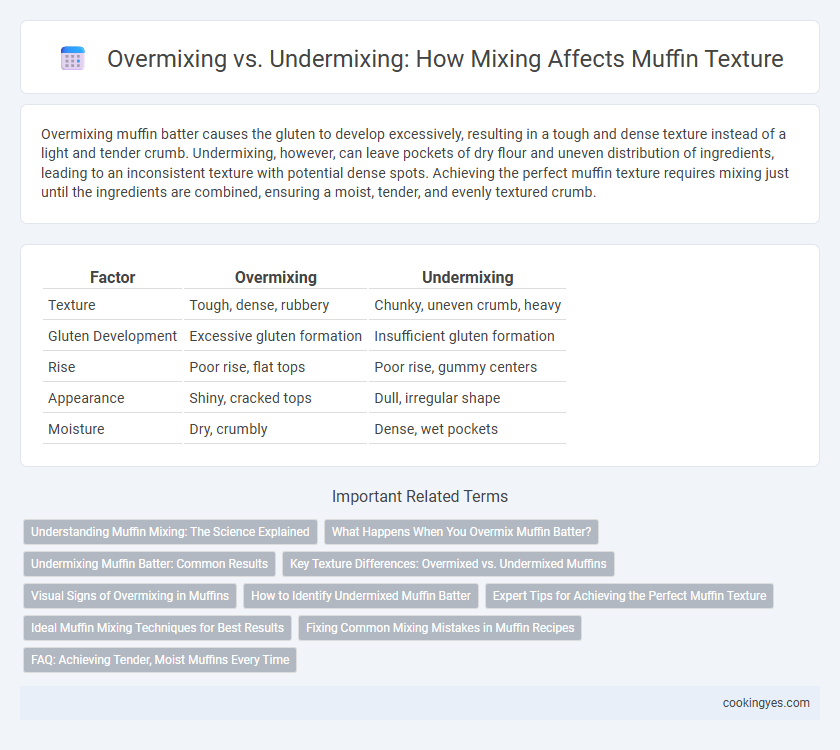Overmixing muffin batter causes the gluten to develop excessively, resulting in a tough and dense texture instead of a light and tender crumb. Undermixing, however, can leave pockets of dry flour and uneven distribution of ingredients, leading to an inconsistent texture with potential dense spots. Achieving the perfect muffin texture requires mixing just until the ingredients are combined, ensuring a moist, tender, and evenly textured crumb.
Table of Comparison
| Factor | Overmixing | Undermixing |
|---|---|---|
| Texture | Tough, dense, rubbery | Chunky, uneven crumb, heavy |
| Gluten Development | Excessive gluten formation | Insufficient gluten formation |
| Rise | Poor rise, flat tops | Poor rise, gummy centers |
| Appearance | Shiny, cracked tops | Dull, irregular shape |
| Moisture | Dry, crumbly | Dense, wet pockets |
Understanding Muffin Mixing: The Science Explained
Overmixing muffin batter develops excessive gluten, leading to tough, dense muffins with peaked tops and tunnels inside. Undermixing results in unevenly distributed ingredients, causing coarse crumbs and irregular texture. Achieving a tender, moist crumb requires just enough mixing to combine ingredients without overworking the gluten network.
What Happens When You Overmix Muffin Batter?
Overmixing muffin batter causes gluten strands to develop excessively, resulting in dense, tough muffins with a peaked, cracked surface. The excessive air incorporated during overmixing can create large tunnels or holes, compromising the desired tender crumb. Achieving the ideal muffin texture requires gentle mixing to combine ingredients just until moistened, preserving lightness and moisture.
Undermixing Muffin Batter: Common Results
Undermixing muffin batter often leads to uneven distribution of ingredients, causing dense, crumbly textures and inconsistent crumb structure. Large pockets of flour or unincorporated leavening agents can result in uneven rising and gummy spots within the muffin. Achieving the ideal muffin texture requires blending just until ingredients are combined to avoid these common undermixing pitfalls.
Key Texture Differences: Overmixed vs. Undermixed Muffins
Overmixed muffins develop a dense, tough texture due to excessive gluten formation, leading to a chewy and heavy crumb. Undermixed muffins have uneven distribution of ingredients, resulting in a coarse, crumbly texture with pockets of dry flour or wet batter. Achieving the ideal muffin texture requires mixing just until ingredients are combined to balance tenderness and structure.
Visual Signs of Overmixing in Muffins
Overmixing muffin batter causes the gluten to develop excessively, resulting in a dense, tough texture with irregular tunnels inside. Visually, overmixed muffins often have a peaked or domed top with large air pockets and a coarse crumb structure. The surface may appear shiny or cracked, signaling too much mixing during preparation.
How to Identify Undermixed Muffin Batter
Undermixed muffin batter often appears lumpy with visible streaks of flour and pockets of unmixed ingredients, resulting in a dense, uneven crumb after baking. When the batter is undermixed, muffins may collapse or have tunnels due to insufficient gluten development and improper ingredient incorporation. Identifying undermixed batter involves checking for a rough texture and unblended portions before baking to ensure a tender, uniform muffin crumb.
Expert Tips for Achieving the Perfect Muffin Texture
Achieving the perfect muffin texture hinges on careful mixing: overmixing the batter develops excessive gluten, resulting in tough, dense muffins, while undermixing leaves pockets of dry flour and causes uneven crumb structure. Experts recommend mixing just until the wet and dry ingredients are combined to ensure a tender, moist interior with a light, airy crumb. Using gentle folding techniques and avoiding high-speed mixers helps maintain the delicate balance for an optimal muffin texture.
Ideal Muffin Mixing Techniques for Best Results
Ideal muffin mixing techniques involve gently combining wet and dry ingredients until just moistened to avoid overmixing, which causes tough, dense muffins due to excessive gluten development. Undermixing can leave pockets of dry flour, resulting in uneven texture and inconsistent crumb structure. Achieving optimal muffin texture requires balancing thorough mixing with minimal agitation to ensure light, tender, and uniformly baked muffins.
Fixing Common Mixing Mistakes in Muffin Recipes
Overmixing muffin batter causes excessive gluten development, resulting in a dense and tough texture, while undermixing leaves pockets of flour causing uneven crumb and dry spots. To fix overmixed batter, gently fold in a small amount of additional liquid or sour cream to restore moisture and tenderness. For undermixed batter, mix just until ingredients are combined, then allow the batter to rest briefly to hydrate the flour evenly before baking.
FAQ: Achieving Tender, Moist Muffins Every Time
Overmixing muffin batter develops excess gluten, resulting in tough, dense muffins, while undermixing leaves pockets of dry flour causing uneven texture. For tender, moist muffins, mix just until ingredients are combined with few small lumps remaining. Using a gentle folding technique preserves air pockets that create a light crumb and optimal moisture retention.
Overmixing vs undermixing for muffin texture Infographic

 cookingyes.com
cookingyes.com